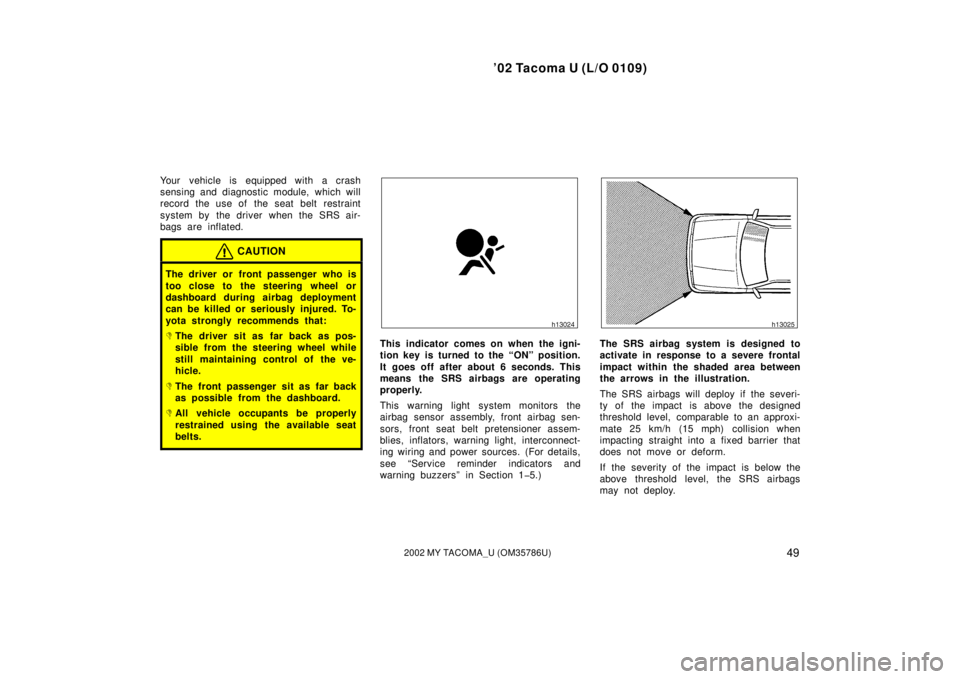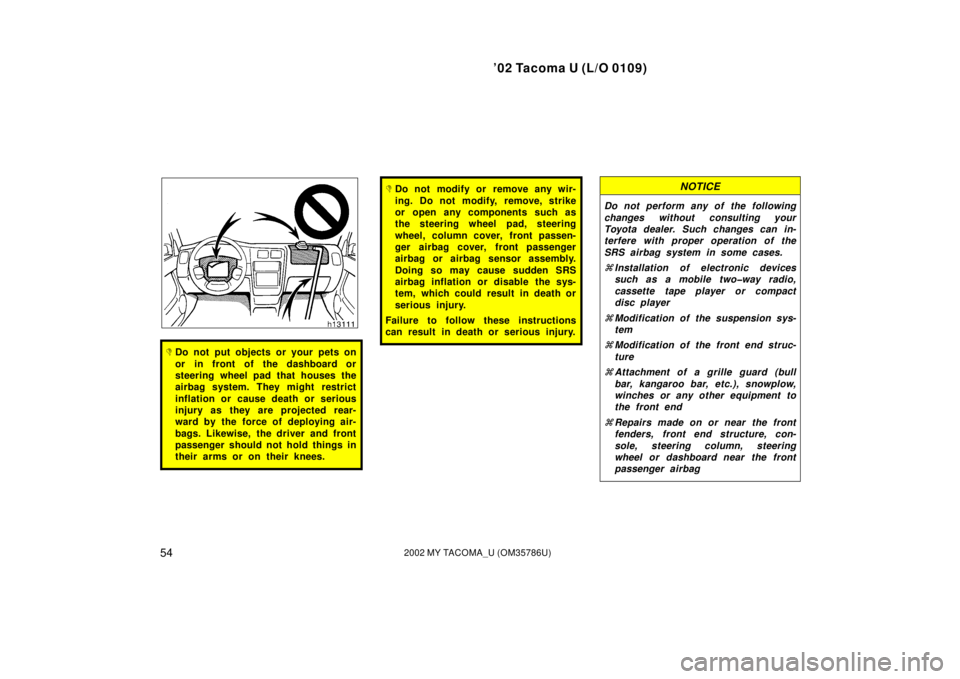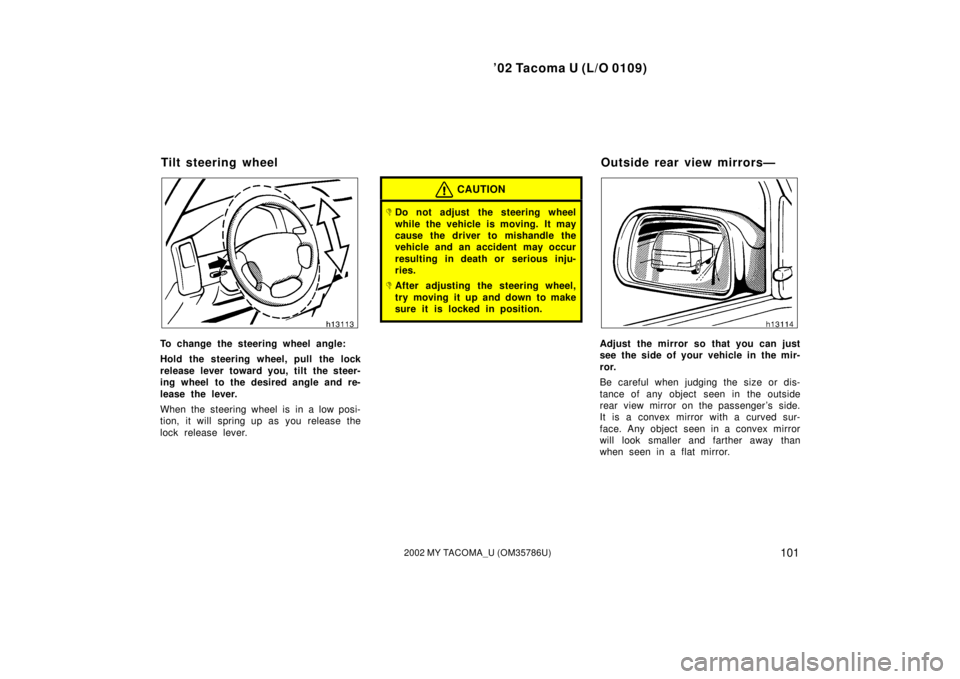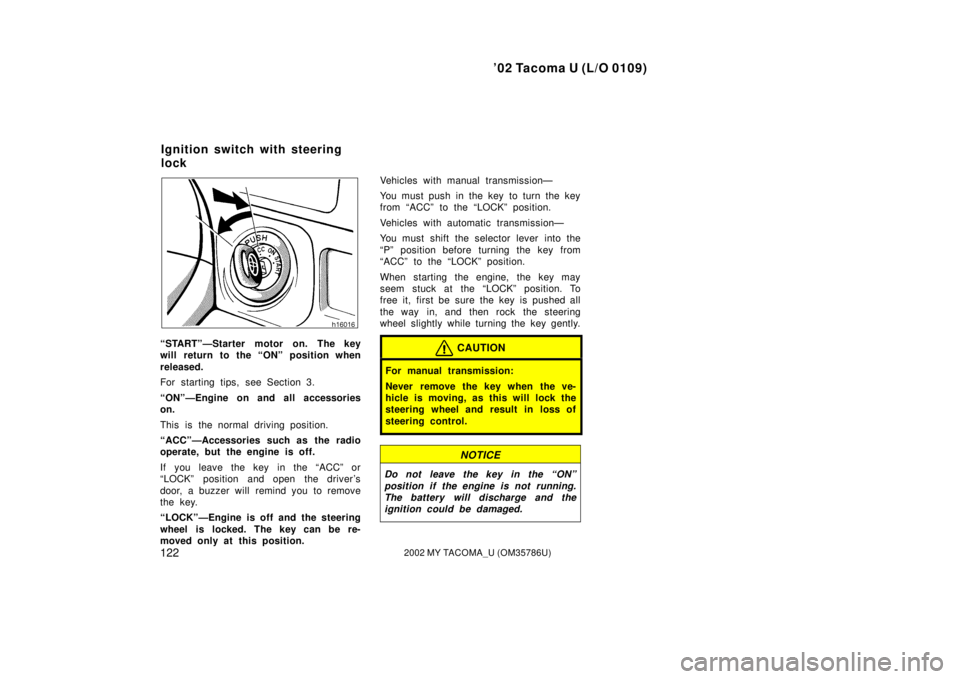Page 54 of 308

’02 Tacoma U (L/O 0109)
482002 MY TACOMA_U (OM35786U)
In the following cases, contact your Toyota
dealer as soon as possible:
�The SRS front airbags have been in-
flated.
�The front of the vehicle (shaded in the
illustration) was involved in an accident
that was not severe enough to cause
the SRS airbags to inflate.
�The pad section of the steering wheel
or front passenger airbag cover
(shaded in the illustration) is scratched,
cracked, or otherwise damaged.
NOTICE
Do not disconnect the battery cables
before contacting your Toyota dealer.
The SRS (Supplemental Restraint Sys-
tem) airbags are designed to provide
further protection for the driver and
front passenger in addition to the pri-
mary safety protection provided by the
seat belts.
In response to a severe frontal impact,
the SRS airbags work together with the
seat belts to help reduce injury by inflat-
ing. The SRS airbags help to reduce inju-
ries mainly to the driver’s or front passen-
ger ’s head or chest caused by directly
hitting the steering wheel or dashboard.
The front passenger airbag is activated
even with no passenger in the front seat.
Be sure to wear your seat belt properly.
SRS driver airbag and front
passenger airbag
(vehicles without passenger airbag
manual on�off switch)
Page 55 of 308

’02 Tacoma U (L/O 0109)
492002 MY TACOMA_U (OM35786U)
Your vehicle is equipped with a crash
sensing and diagnostic module, which will
record the use of the seat belt restraint
system by the driver when the SRS air-
bags are inflated.
CAUTION
The driver or front passenger who is
too close to the steering wheel or
dashboard during airbag deployment
can be killed or seriously injured. To-
yota strongly recommends that:
�The driver sit as far back as pos-
sible from the steering wheel while
still maintaining control of the ve-
hicle.
�The front passenger sit as far back
as possible from the dashboard.
�All vehicle occupants be properly
restrained using the available seat
belts.
This indicator comes on when the igni-
tion key is turned to the “ON” position.
It goes off after about 6 seconds. This
means the SRS airbags are operating
properly.
This warning light system monitors the
airbag sensor assembly, front airbag sen-
sors, front seat belt pretensioner assem-
blies, inflators, warning light, interconnect-
ing wiring and power sources. (For details,
see “Service reminder indicators and
warning buzzers” in Section 1�5.)The SRS airbag system is designed to
activate in response to a severe frontal
impact within the shaded area between
the arrows in the illustration.
The SRS airbags will deploy if the severi-
ty of the impact is above the designed
threshold level, comparable to an approxi-
mate 25 km/h (15 mph) collision when
impacting straight into a fixed barrier that
does not move or deform.
If the severity of the impact is below the
above threshold level, the SRS airbags
may not deploy.
Page 57 of 308

’02 Tacoma U (L/O 0109)
512002 MY TACOMA_U (OM35786U)
The SRS airbag system consists mainly of
the following components, and their loca-
tions are shown in the illustration.1. Front airbag sensors
2. Airbag module for driver (airbag and inflator)
3. Airbag module for front passenger (airbag and inflator)
4. Airbag sensor assembly
5. SRS warning light
The airbag sensor assembly consists of a
safing sensor and airbag sensor. In a severe frontal impact, the sensors
detect deceleration and the system trig-
gers the airbag inflators. Then a chemical
reaction in the inflators quickly fills the
airbags with non�toxic gas to help restrain
the forward motion of the occupants.
When the airbags inflate, they produce a
fairly loud noise and release some smoke
and residue along with non�toxic gas. This
does not indicate a fire. This gas is nor-
mally harmless; however, for those who
have delicate skin, it may cause a minor
skin irritation. Be sure to wash off any
residue as soon as possible to prevent
any potential skin irritation.
Deployment of the airbags happens in a
fraction of a second, so the airbags must
inflate with considerable force. While the
system is desi
gned to reduce serious inju-
ries, it may also cause minor burns or
abrasions and swelling.
Parts of the airbag module (steering wheel
hub, dashboard) may be hot for several
minutes, but the airbags themselves will
not be hot. The airbags are designed to
inflate only once. A crash severe enough to inflate the air-
bags may break the windshield as the
vehicle buckles. In vehicles with a pas-
senger airbag the windshield may also be
damaged by absorbing some of the force
of the inflating airbag.
Page 60 of 308

’02 Tacoma U (L/O 0109)
542002 MY TACOMA_U (OM35786U)
�Do not put objects or your pets on
or in front of the dashboard or
steering wheel pad that houses the
airbag system. They might restrict
inflation or cause death or serious
injury as they are projected rear-
ward by the force of deploying air-
bags. Likewise, the driver and front
passenger should not hold things in
their arms or on their knees.
�Do not modify or remove any wir-
ing. Do not modify, remove, strike
or open any components such as
the steering wheel pad, steering
wheel, column cover, front passen-
ger airbag cover, front passenger
airbag or airbag sensor assembly.
Doing so may cause sudden SRS
airbag inflation or disable the sys-
tem, which could result in death or
serious injury.
Failure to follow these instructions
can result in death or serious injury.NOTICE
Do not perform any of the following
changes without consulting your
Toyota dealer. Such changes can in-
terfere with proper operation of the
SRS airbag system in some cases.
� Installation of electronic devices
such as a mobile two�way radio,
cassette tape player or compact
disc player
� Modification of the suspension sys-
tem
� Modification of the front end struc-
ture
� Attachment of a grille guard (bull
bar, kangaroo bar, etc.), snowplow,
winches or any other equipment to
the front end
� Repairs made on or near the front
fenders, front end structure, con-
sole, steering column, steering
wheel or dashboard near the front
passenger airbag
Page 61 of 308
’02 Tacoma U (L/O 0109)
552002 MY TACOMA_U (OM35786U)
This SRS airbag system has a service
reminder indicator to inform the driver of
operating problems. If either of the follow-
ing conditions occurs, this indicates a mal-
function of the airbags. Contact your
Toyota dealer as soon as possible to ser-
vice the vehicle.
�The light does not come on when the
ignition key is turned to the “ON” posi-
tion, or the light remains on.
�The light comes on while driving.
In the following cases, contact your Toyota
dealer as soon as possible:
�The SRS front airbags have been in-
flated.
�The front of the vehicle (shaded in the
illustration) was involved in an accident
that was not severe enough to cause
the SRS airbags to inflate.
�The pad section of the steering wheel
or front passenger airbag cover
(shaded in the illustration) is scratched,
cracked, or otherwise damaged.
NOTICE
Do not disconnect the battery cables
before contacting your Toyota dealer.
Page 107 of 308

’02 Tacoma U (L/O 0109)
1012002 MY TACOMA_U (OM35786U)
To change the steering wheel angle:
Hold the steering wheel, pull the lock
release lever toward you, tilt the steer-
ing wheel to the desired angle and re-
lease the lever.
When the steering wheel is in a low posi-
tion, it will spring up as you release the
lock release lever.
CAUTION
�Do not adjust the steering wheel
while the vehicle is moving. It may
cause the driver to mishandle the
vehicle and an accident may occur
resulting in death or serious inju-
ries.
�After adjusting the steering wheel,
try moving it up and down to make
sure it is locked in position.
Adjust the mirror so that you can just
see the side of your vehicle in the mir-
ror.
Be careful when judging the size or dis-
tance of any object seen in the outside
rear view mirror on the passenger ’s side.
It is a convex mirror with a curved sur-
face. Any object seen in a convex mirror
will look smaller and farther away than
when seen in a flat mirror.
Tilt steering wheelOutside rear view mirrors—
Page 127 of 308

’02 Tacoma U (L/O 0109)
1212002 MY TACOMA_U (OM35786U)
OPERATION OF INSTRUMENTS AND
CONTROLS
Ignition switch, Transmission and Parking brake
Ignition switch with steering lock122
. . . . . . . . . . . . . . . . . . . . . . . . . . . . . .
Automatic transmission 123
. . . . . . . . . . . . . . . . . . . . . . . . . . . . . . . . . . . . \
.
Manual transmission 128
. . . . . . . . . . . . . . . . . . . . . . . . . . . . . . . . . . . . \
. . . .
Four�wheel drive system 130
. . . . . . . . . . . . . . . . . . . . . . . . . . . . . . . . . . . . \
Rear differential lock system 134
. . . . . . . . . . . . . . . . . . . . . . . . . . . . . . . . .
Parking brake 136
. . . . . . . . . . . . . . . . . . . . . . . . . . . . . . . . . . . . \
. . . . . . . . . .
Cruise control 136
. . . . . . . . . . . . . . . . . . . . . . . . . . . . . . . . . . . . \
. . . . . . . . . .
Clutch start cancel switch 139
. . . . . . . . . . . . . . . . . . . . . . . . . . . . . . . . . . . . \
SECTION 1� 6
Page 128 of 308

’02 Tacoma U (L/O 0109)
1222002 MY TACOMA_U (OM35786U)
“START”—Starter motor on. The key
will return to the “ON” position when
released.
For starting tips, see Section 3.
“ON”—Engine on and all accessories
on.
This is the normal driving position.
“ACC”—Accessories such as the radio
operate, but the engine is off.
If you leave the key in the “ACC” or
“LOCK” position and open the driver’s
door, a buzzer will remind you to remove
the key.
“LOCK”—Engine is off and the steering
wheel is locked. The key can be re-
moved only at this position.Vehicles with manual transmission—
You must push in the key to turn the key
from “ACC” to the “LOCK” position.
Vehicles with automatic transmission—
You must shift the selector lever into the
“P” position before turning the key from
“ACC” to the “LOCK” position.
When starting the engine, the key may
seem stuck at the “LOCK” position. To
free it, first be sure the key is pushed all
the way in, and then rock the steering
wheel slightly while turning the key gently.CAUTION
For manual transmission:
Never remove the key when the ve-
hicle is moving, as this will lock the
steering wheel and result in loss of
steering control.
NOTICE
Do not leave the key in the “ON”
position if the engine is not running.
The battery will discharge and the
ignition could be damaged.
Ignition switch with steering
lock